TOYOTA PRIUS PRIME 2023 Owners Manual
Manufacturer: TOYOTA, Model Year: 2023, Model line: PRIUS PRIME, Model: TOYOTA PRIUS PRIME 2023Pages: 680, PDF Size: 14.97 MB
Page 341 of 680
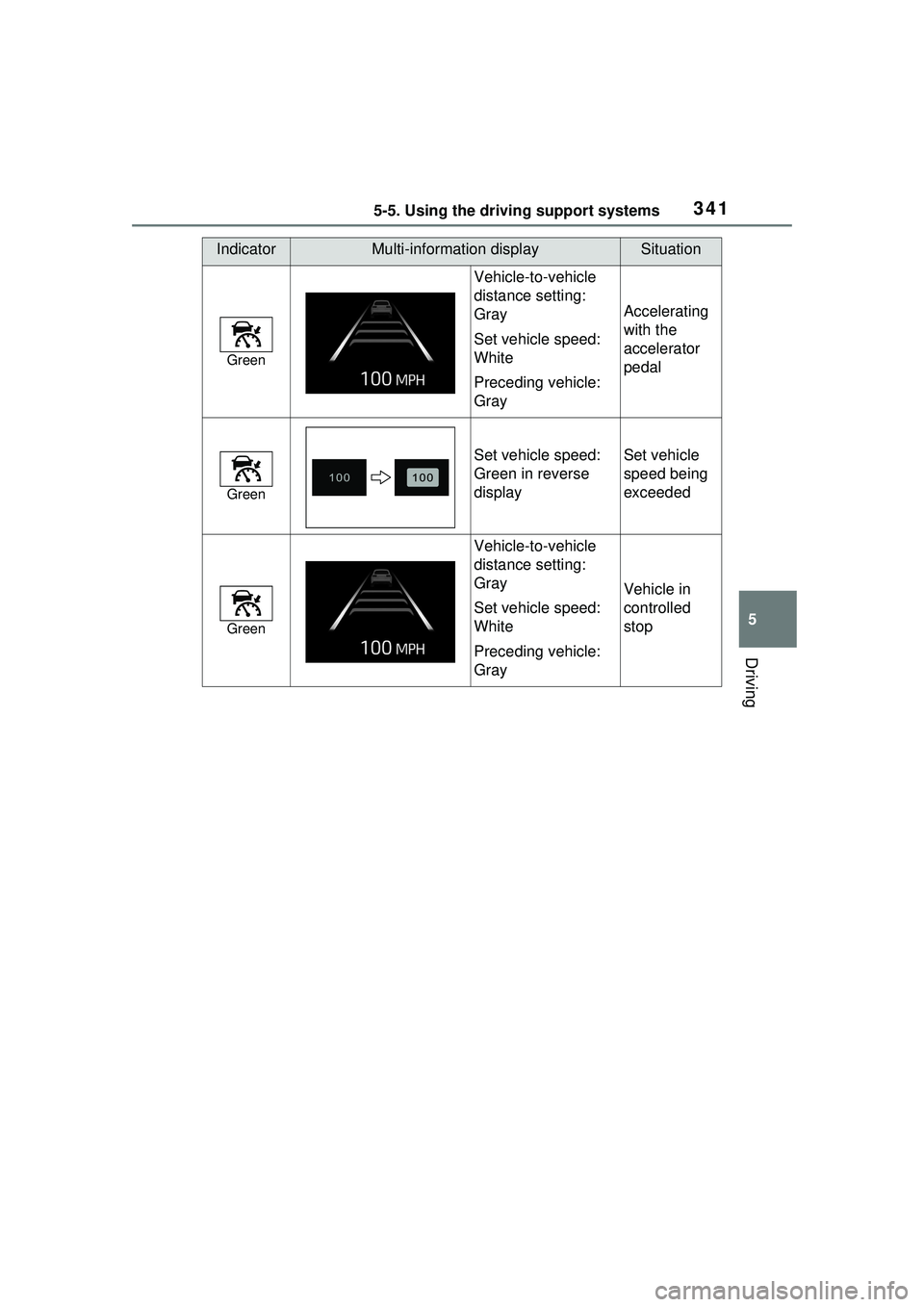
3415-5. Using the driving support systems
5
Driving
Green
Vehicle-to-vehicle
distance setting:
Gray
Set vehicle speed:
White
Preceding vehicle:
Gray
Accelerating
with the
accelerator
pedal
Green
Set vehicle speed:
Green in reverse
displaySet vehicle
speed being
exceeded
Green
Vehicle-to-vehicle
distance setting:
Gray
Set vehicle speed:
White
Preceding vehicle:
Gray
Vehicle in
controlled
stop
IndicatorMulti-information displaySituation
Page 342 of 680
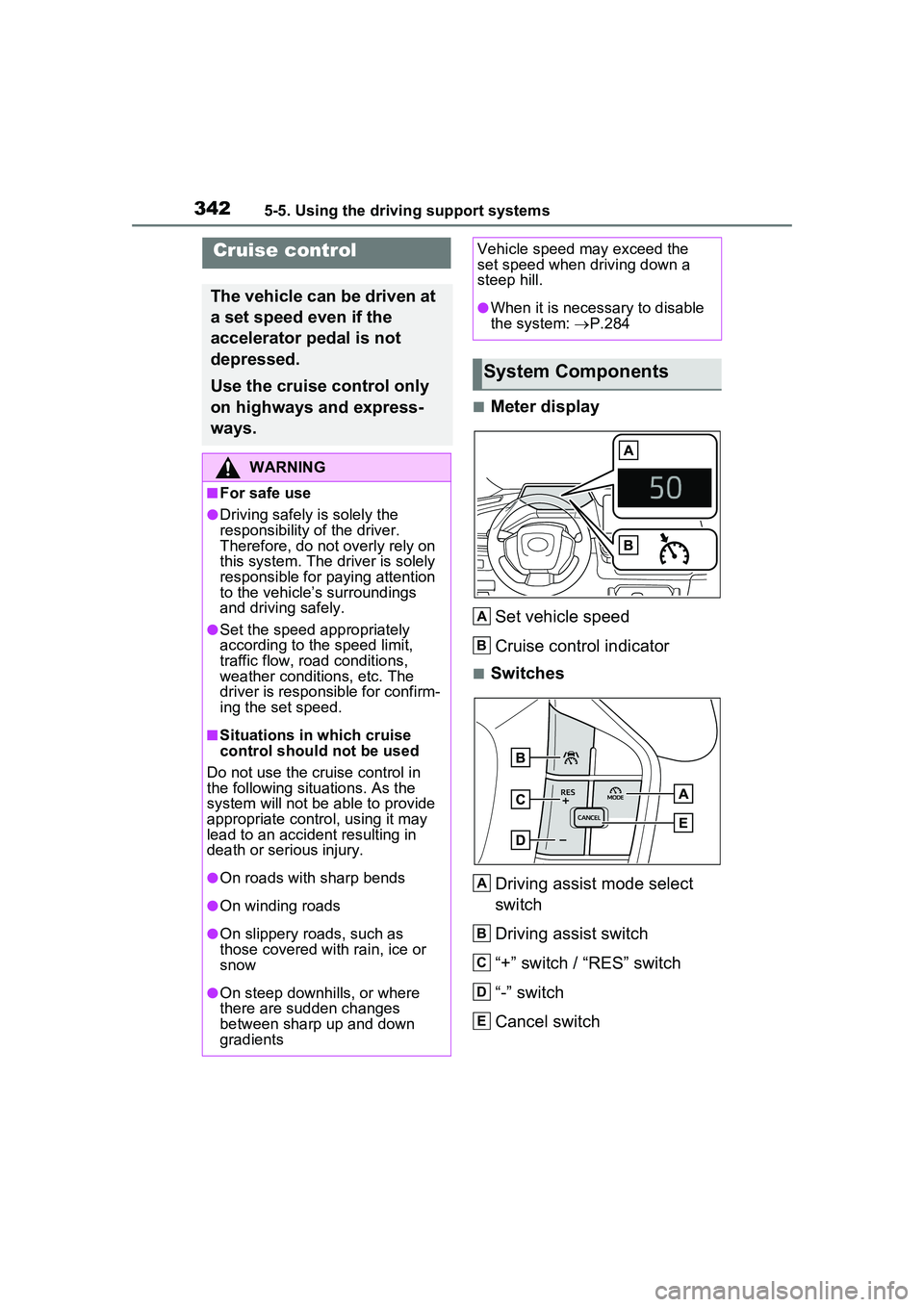
3425-5. Using the driving support systems
■Meter displaySet vehicle speed
Cruise control indicator
■SwitchesDriving assist mode select
switch
Driving assist switch
“+” switch / “RES” switch
“-” switch
Cancel switch
Cruise control
The vehicle can be driven at
a set speed even if the
accelerator pedal is not
depressed.
Use the cruise control only
on highways and express-
ways.
WARNING
■For safe use
●Driving safely is solely the
responsibility of the driver.
Therefore, do not overly rely on
this system. The driver is solely
responsible for paying attention
to the vehicle’s surroundings
and driving safely.
●Set the speed appropriately
according to the speed limit,
traffic flow, road conditions,
weather conditions, etc. The
driver is responsible for confirm-
ing the set speed.
■Situations in which cruise
control should not be used
Do not use the cruise control in
the following situations. As the
system will not be able to provide
appropriate control, using it may
lead to an accident resulting in
death or serious injury.
●On roads with sharp bends
●On winding roads
●On slippery roads, such as
those covered with rain, ice or
snow
●On steep downhills, or where
there are sudden changes
between sharp up and down
gradients
Vehicle speed may exceed the
set speed when driving down a
steep hill.
●When it is necessary to disable
the system: P.284
System Components
A
B
A
B
C
D
E
Page 343 of 680
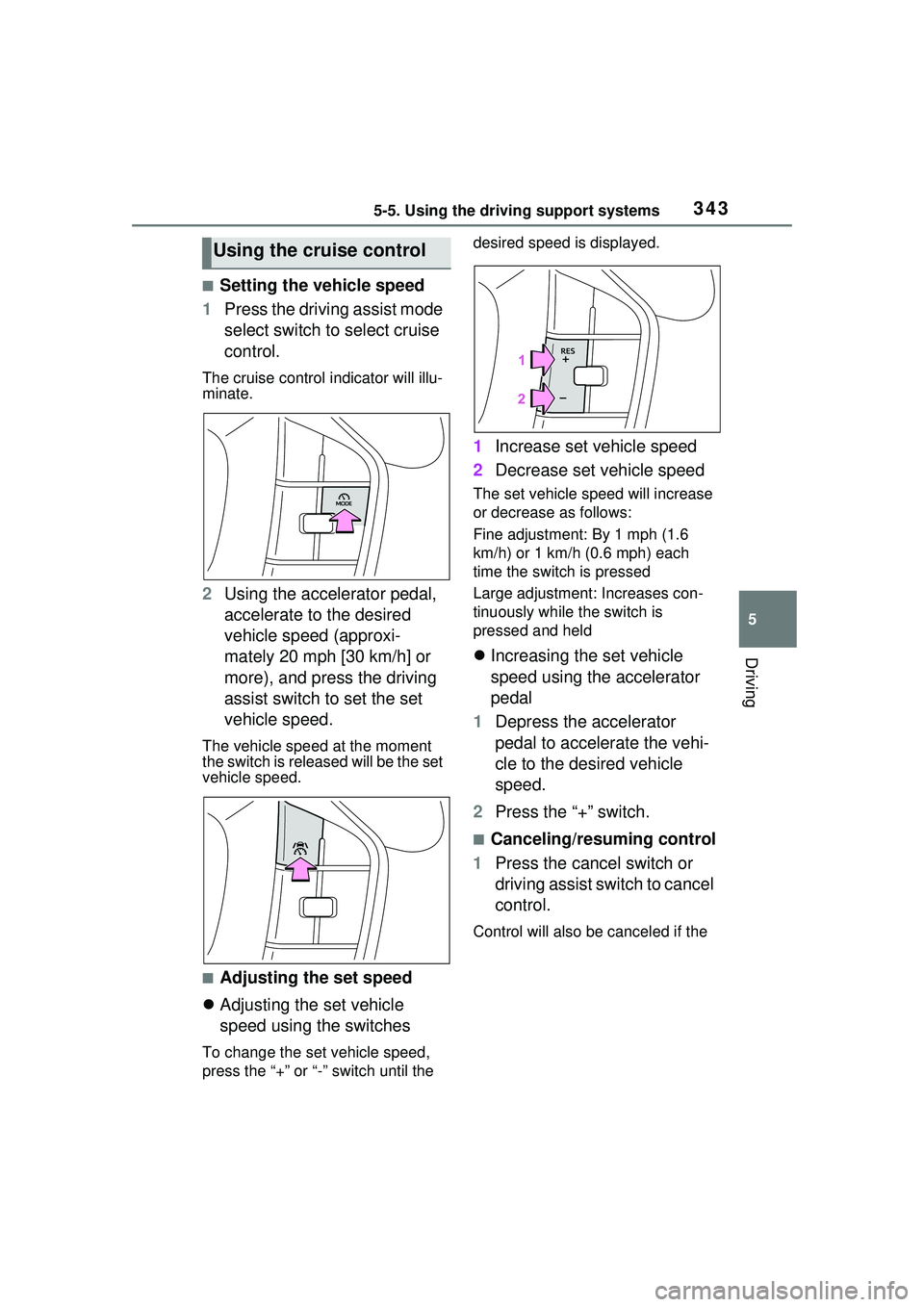
3435-5. Using the driving support systems
5
Driving
■Setting the vehicle speed
1 Press the driving assist mode
select switch to select cruise
control.
The cruise control indicator will illu-
minate.
2Using the accelerator pedal,
accelerate to the desired
vehicle speed (approxi-
mately 20 mph [30 km/h] or
more), and press the driving
assist switch to set the set
vehicle speed.
The vehicle speed at the moment
the switch is released will be the set
vehicle speed.
■Adjusting the set speed
Adjusting the set vehicle
speed using the switches
To change the set vehicle speed,
press the “+” or “-” switch until the desired speed is displayed.
1
Increase set vehicle speed
2 Decrease set vehicle speed
The set vehicle speed will increase
or decrease as follows:
Fine adjustment: By 1 mph (1.6
km/h) or 1 km/h (0.6 mph) each
time the switch is pressed
Large adjustment: Increases con-
tinuously while the switch is
pressed and held
Increasing the set vehicle
speed using the accelerator
pedal
1 Depress the accelerator
pedal to accelerate the vehi-
cle to the desired vehicle
speed.
2 Press the “+” switch.
■Canceling/resuming control
1 Press the cancel switch or
driving assist switch to cancel
control.
Control will also be canceled if the
Using the cruise control
Page 344 of 680
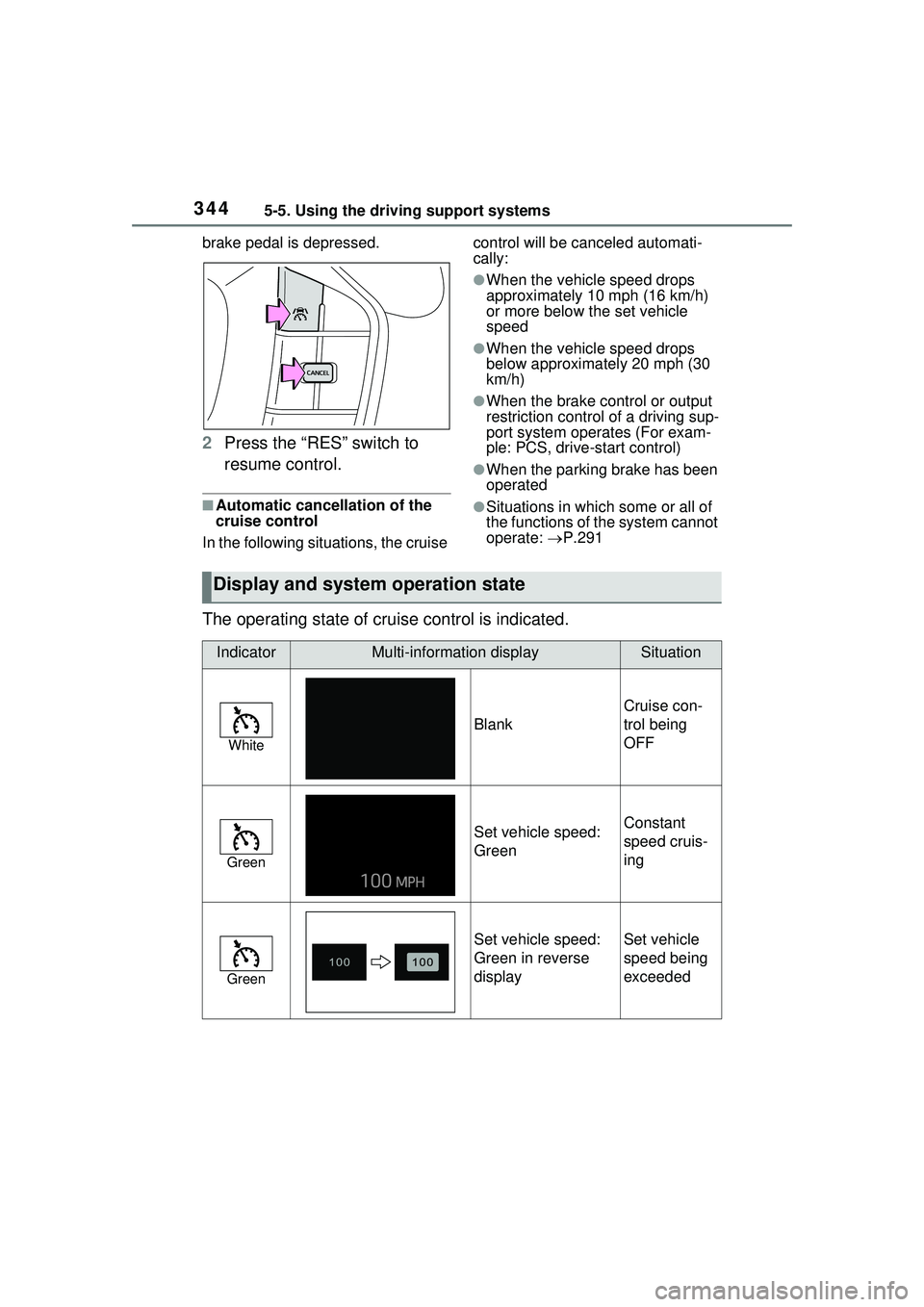
3445-5. Using the driving support systems
brake pedal is depressed.
2Press the “RES” switch to
resume control.
■Automatic cancellation of the
cruise control
In the following situations, the cruise control will be canceled automati-
cally:
●When the vehicle speed drops
approximately 10 mph (16 km/h)
or more below the set vehicle
speed
●When the vehicle speed drops
below approximately 20 mph (30
km/h)
●When the brake control or output
restriction control of a driving sup-
port system operates (For exam-
ple: PCS, drive-start control)
●When the parking brake has been
operated
●Situations in which some or all of
the functions of the system cannot
operate:
P.291
The operating state of cruise control is indicated.
Display and system operation state
IndicatorMulti-information displaySituation
White
Blank
Cruise con-
trol being
OFF
Green
Set vehicle speed:
GreenConstant
speed cruis-
ing
Green
Set vehicle speed:
Green in reverse
displaySet vehicle
speed being
exceeded
Page 345 of 680
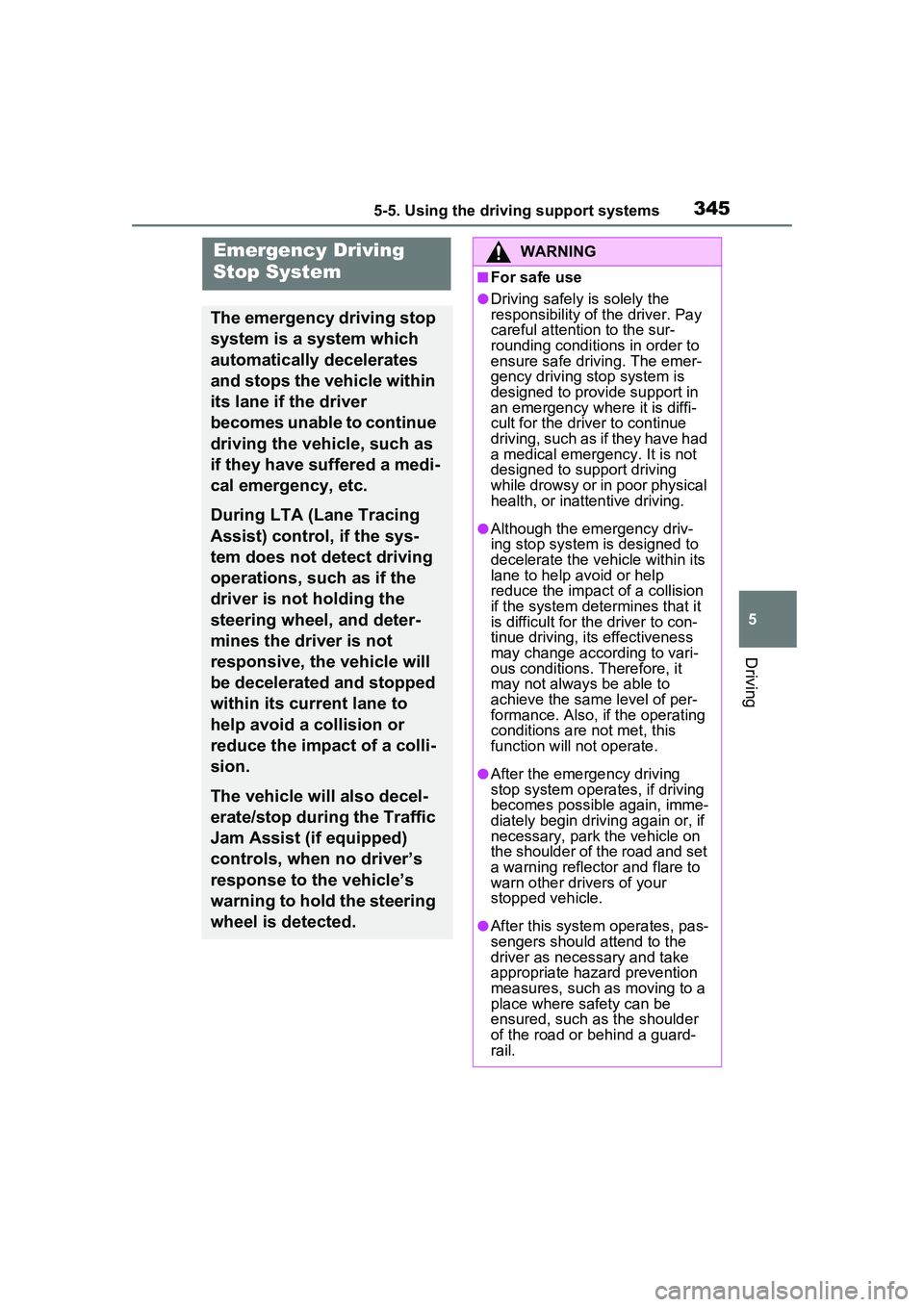
3455-5. Using the driving support systems
5
Driving
Emergency Driving
Stop System
The emergency driving stop
system is a system which
automatically decelerates
and stops the vehicle within
its lane if the driver
becomes unable to continue
driving the vehicle, such as
if they have suffered a medi-
cal emergency, etc.
During LTA (Lane Tracing
Assist) control, if the sys-
tem does not detect driving
operations, such as if the
driver is not holding the
steering wheel, and deter-
mines the driver is not
responsive, the vehicle will
be decelerated and stopped
within its current lane to
help avoid a collision or
reduce the impact of a colli-
sion.
The vehicle will also decel-
erate/stop during the Traffic
Jam Assist (if equipped)
controls, when no driver’s
response to the vehicle’s
warning to hold the steering
wheel is detected.
WARNING
■For safe use
●Driving safely is solely the
responsibility of the driver. Pay
careful attention to the sur-
rounding conditions in order to
ensure safe driving. The emer-
gency driving stop system is
designed to provide support in
an emergency where it is diffi-
cult for the driver to continue
driving, such as if they have had
a medical emergency. It is not
designed to support driving
while drowsy or in poor physical
health, or inattentive driving.
●Although the emergency driv-
ing stop system is designed to
decelerate the vehicle within its
lane to help avoid or help
reduce the impact of a collision
if the system determines that it
is difficult for the driver to con-
tinue driving, its effectiveness
may change according to vari-
ous conditions. Therefore, it
may not always be able to
achieve the same level of per-
formance. Also, if the operating
conditions are not met, this
function will not operate.
●After the emergency driving
stop system operates, if driving
becomes possible again, imme-
diately begin driving again or, if
necessary, park the vehicle on
the shoulder of the road and set
a warning reflector and flare to
warn other drivers of your
stopped vehicle.
●After this system operates, pas-
sengers should attend to the
driver as necessary and take
appropriate hazard prevention
measures, such as moving to a
place where safety can be
ensured, such as the shoulder
of the road or behind a guard-
rail.
Page 346 of 680
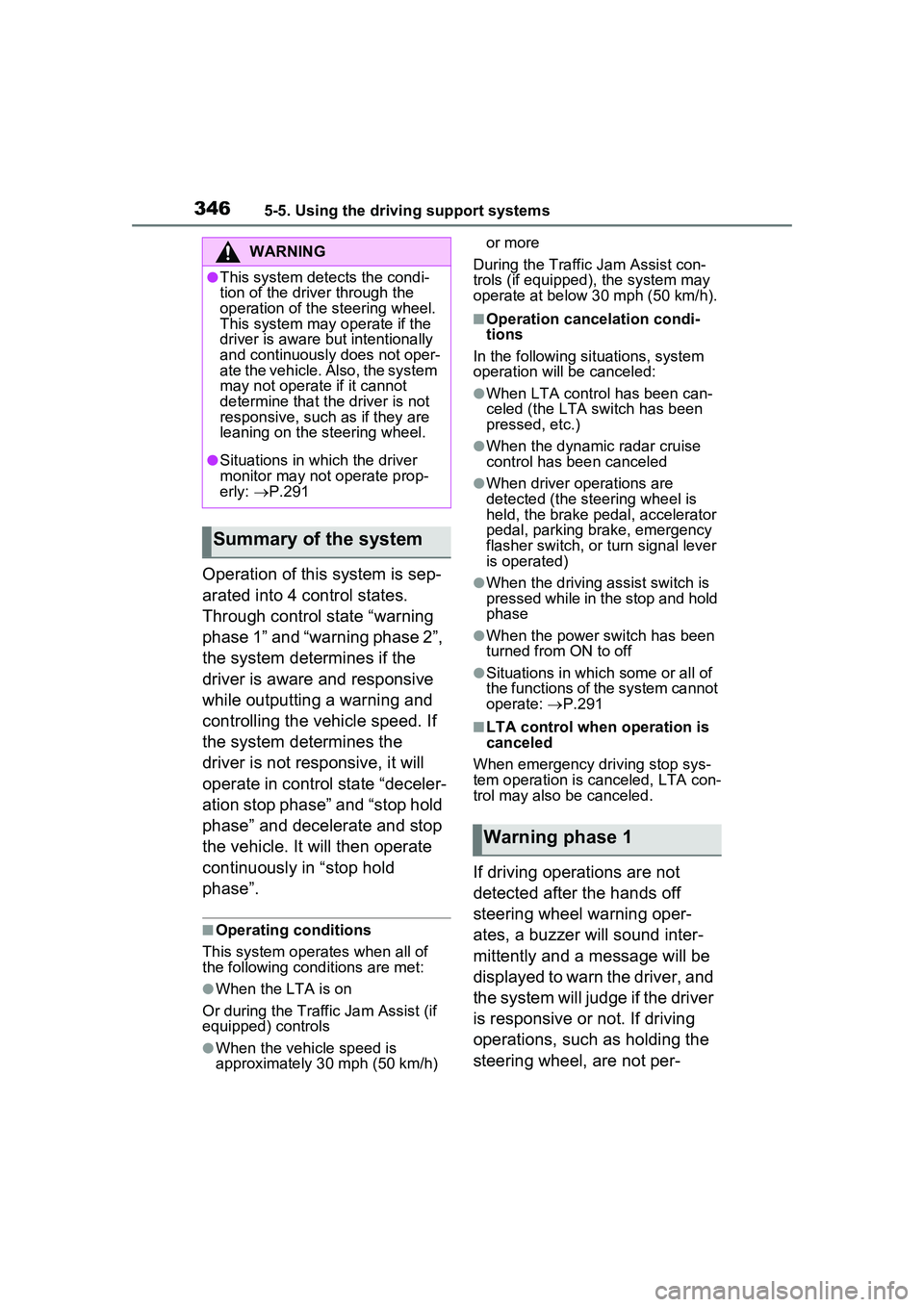
3465-5. Using the driving support systems
Operation of this system is sep-
arated into 4 control states.
Through control state “warning
phase 1” and “warning phase 2”,
the system determines if the
driver is aware and responsive
while outputting a warning and
controlling the vehicle speed. If
the system determines the
driver is not responsive, it will
operate in control state “deceler-
ation stop phase” and “stop hold
phase” and decelerate and stop
the vehicle. It will then operate
continuously in “stop hold
phase”.
■Operating conditions
This system operates when all of
the following conditions are met:
●When the LTA is on
Or during the Traffic Jam Assist (if
equipped) controls
●When the vehicle speed is
approximately 30 mph (50 km/h) or more
During the Traffic Jam Assist con-
trols (if equipped), the system may
operate at below 30 mph (50 km/h).
■Operation cancelation condi-
tions
In the following si tuations, system
operation will be canceled:
●When LTA control has been can-
celed (the LTA switch has been
pressed, etc.)
●When the dynamic radar cruise
control has been canceled
●When driver operations are
detected (the steering wheel is
held, the brake pedal, accelerator
pedal, parking brake, emergency
flasher switch, or turn signal lever
is operated)
●When the driving assist switch is
pressed while in the stop and hold
phase
●When the power switch has been
turned from ON to off
●Situations in which some or all of
the functions of the system cannot
operate: P.291
■LTA control when operation is
canceled
When emergency driving stop sys-
tem operation is canceled, LTA con-
trol may also be canceled.
If driving operations are not
detected after the hands off
steering wheel warning oper-
ates, a buzzer will sound inter-
mittently and a message will be
displayed to warn the driver, and
the system will judge if the driver
is responsive or not. If driving
operations, such as holding the
steering wheel, are not per-
WARNING
●This system detects the condi-
tion of the driver through the
operation of the steering wheel.
This system may operate if the
driver is aware but intentionally
and continuously does not oper-
ate the vehicle. Also, the system
may not operate if it cannot
determine that the driver is not
responsive, such as if they are
leaning on the steering wheel.
●Situations in which the driver
monitor may not operate prop-
erly: P.291
Summary of the system
Warning phase 1
Page 347 of 680
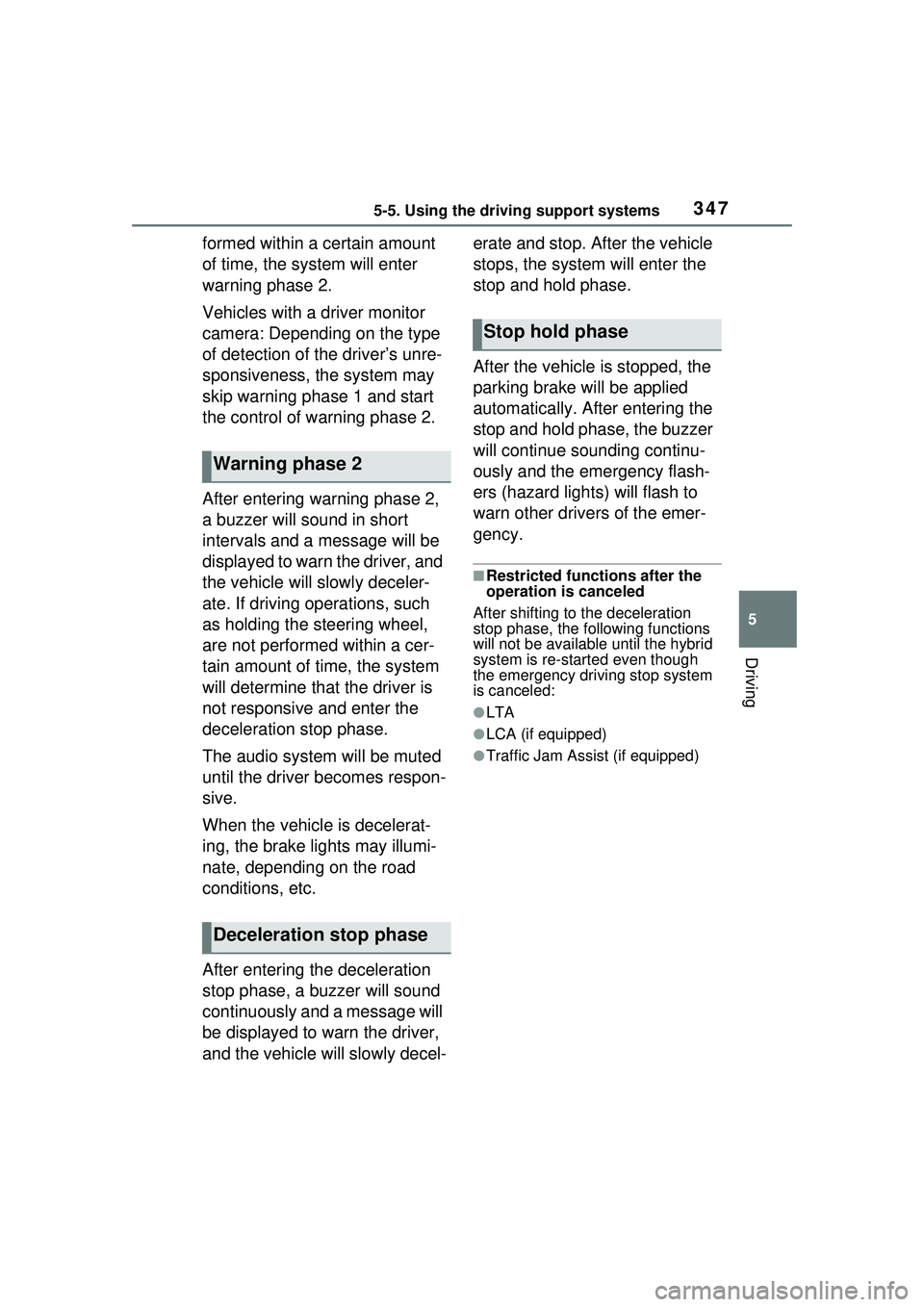
3475-5. Using the driving support systems
5
Driving
formed within a certain amount
of time, the system will enter
warning phase 2.
Vehicles with a driver monitor
camera: Depending on the type
of detection of the driver’s unre-
sponsiveness, the system may
skip warning phase 1 and start
the control of warning phase 2.
After entering warning phase 2,
a buzzer will sound in short
intervals and a message will be
displayed to warn the driver, and
the vehicle will slowly deceler-
ate. If driving operations, such
as holding the steering wheel,
are not performed within a cer-
tain amount of time, the system
will determine that the driver is
not responsive and enter the
deceleration stop phase.
The audio system will be muted
until the driver becomes respon-
sive.
When the vehicle is decelerat-
ing, the brake lights may illumi-
nate, depending on the road
conditions, etc.
After entering the deceleration
stop phase, a buzzer will sound
continuously and a message will
be displayed to warn the driver,
and the vehicle will slowly decel-erate and stop. After the vehicle
stops, the system will enter the
stop and hold phase.
After the vehicle is stopped, the
parking brake will be applied
automatically. After entering the
stop and hold phase, the buzzer
will continue sounding continu-
ously and the emergency flash-
ers (hazard lights) will flash to
warn other drivers of the emer-
gency.
■Restricted functions after the
operation is canceled
After shifting to the deceleration
stop phase, the following functions
will not be available until the hybrid
system is re-started even though
the emergency driving stop system
is canceled:
●LTA
●LCA (if equipped)
●Traffic Jam Assist (if equipped)
Warning phase 2
Deceleration stop phase
Stop hold phase
Page 348 of 680
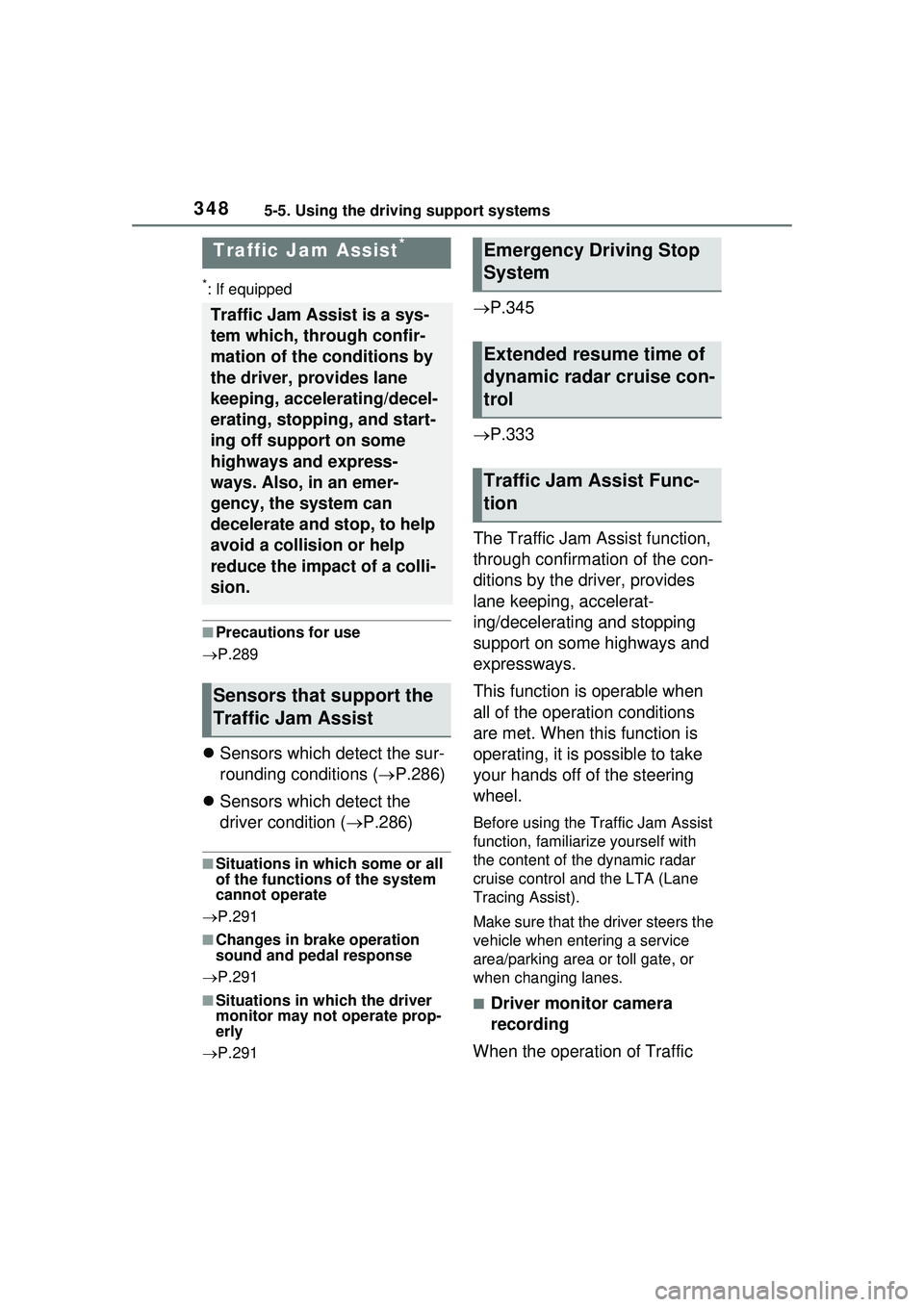
3485-5. Using the driving support systems
*: If equipped
■Precautions for use
P.289
Sensors which detect the sur-
rounding conditions ( P.286)
Sensors which detect the
driver condition ( P.286)
■Situations in which some or all
of the functions of the system
cannot operate
P.291
■Changes in brake operation
sound and pedal response
P.291
■Situations in which the driver
monitor may not operate prop-
erly
P.291
P.345
P.333
The Traffic Jam Assist function,
through confirmation of the con-
ditions by the driver, provides
lane keeping, accelerat-
ing/decelerating and stopping
support on some highways and
expressways.
This function is operable when
all of the operation conditions
are met. When this function is
operating, it is possible to take
your hands off of the steering
wheel.
Before using the Traffic Jam Assist
function, familiari ze yourself with
the content of the dynamic radar
cruise control and the LTA (Lane
Tracing Assist).
Make sure that the driver steers the
vehicle when entering a service
area/parking area or toll gate, or
when changing lanes.
■Driver monitor camera
recording
When the operation of Traffic
Traffic Jam Assist*
Traffic Jam Assist is a sys-
tem which, through confir-
mation of the conditions by
the driver, provides lane
keeping, accelerating/decel-
erating, stopping, and start-
ing off support on some
highways and express-
ways. Also, in an emer-
gency, the system can
decelerate and stop, to help
avoid a collision or help
reduce the impact of a colli-
sion.
Sensors that support the
Traffic Jam Assist
Emergency Driving Stop
System
Extended resume time of
dynamic radar cruise con-
trol
Traffic Jam Assist Func-
tion
Page 349 of 680
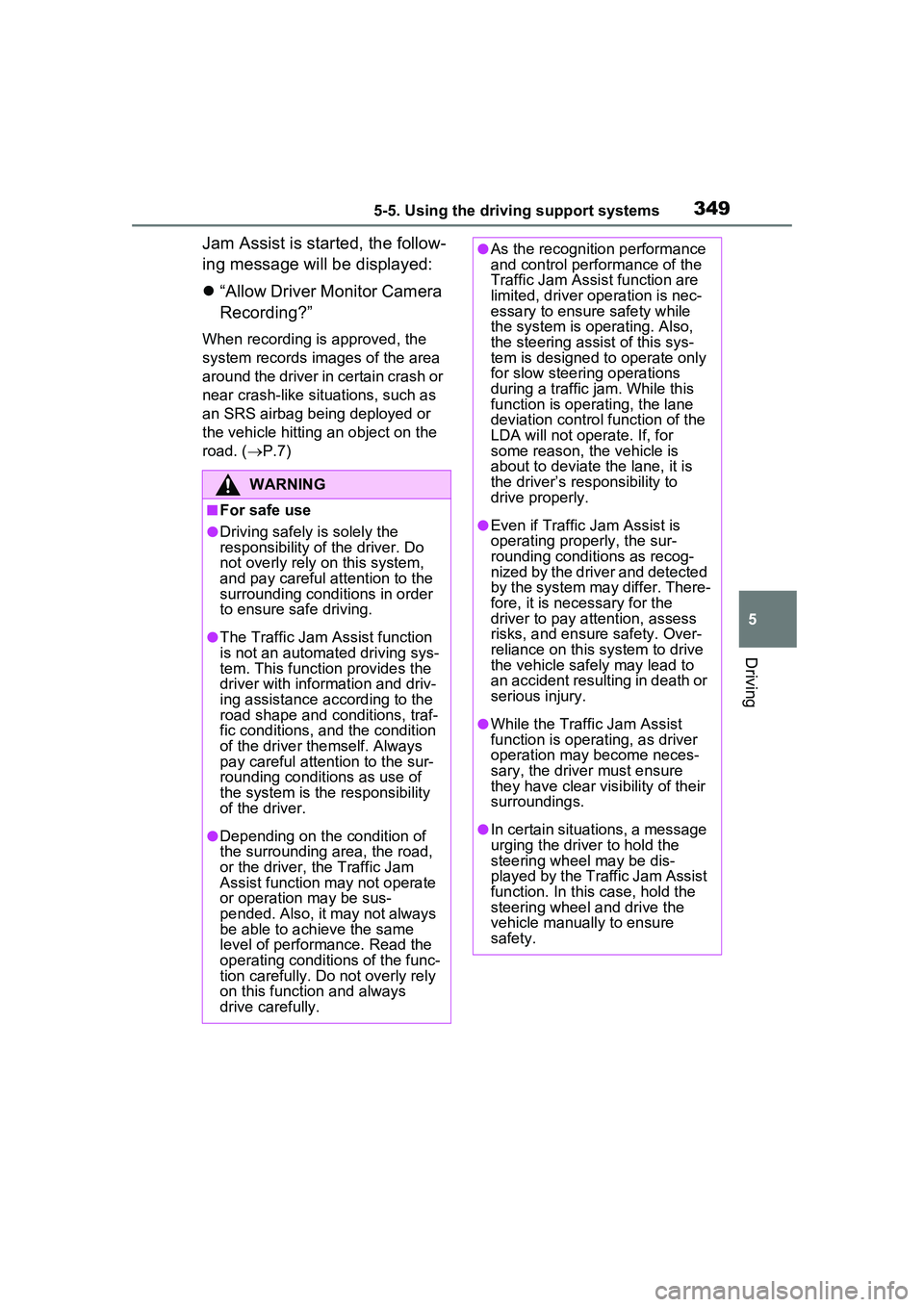
3495-5. Using the driving support systems
5
Driving
Jam Assist is started, the follow-
ing message will be displayed:
“Allow Driver Monitor Camera
Recording?”
When recording is approved, the
system records images of the area
around the driver in certain crash or
near crash-like situations, such as
an SRS airbag being deployed or
the vehicle hitting an object on the
road. ( P.7)
WARNING
■For safe use
●Driving safely is solely the
responsibility of the driver. Do
not overly rely on this system,
and pay careful attention to the
surrounding conditions in order
to ensure safe driving.
●The Traffic Jam Assist function
is not an automated driving sys-
tem. This function provides the
driver with information and driv-
ing assistance a ccording to the
road shape and conditions, traf-
fic conditions, and the condition
of the driver themself. Always
pay careful attention to the sur-
rounding conditions as use of
the system is the responsibility
of the driver.
●Depending on the condition of
the surrounding area, the road,
or the driver, the Traffic Jam
Assist function may not operate
or operation may be sus-
pended. Also, it may not always
be able to achieve the same
level of performance. Read the
operating conditions of the func-
tion carefully. Do not overly rely
on this function and always
drive carefully.
●As the recognition performance
and control performance of the
Traffic Jam Assist function are
limited, driver operation is nec-
essary to ensure safety while
the system is operating. Also,
the steering assist of this sys-
tem is designed to operate only
for slow steering operations
during a traffic jam. While this
function is operating, the lane
deviation control function of the
LDA will not operate. If, for
some reason, the vehicle is
about to deviate the lane, it is
the driver’s responsibility to
drive properly.
●Even if Traffic Jam Assist is
operating properly, the sur-
rounding conditions as recog-
nized by the driver and detected
by the system may differ. There-
fore, it is necessary for the
driver to pay attention, assess
risks, and ensure safety. Over-
reliance on this system to drive
the vehicle safely may lead to
an accident resulting in death or
serious injury.
●While the Traffi c Jam Assist
function is operating, as driver
operation may become neces-
sary, the driver must ensure
they have clear visibility of their
surroundings.
●In certain situations, a message
urging the driver to hold the
steering wheel may be dis-
played by the Traffic Jam Assist
function. In this case, hold the
steering wheel and drive the
vehicle manually to ensure
safety.
Page 350 of 680
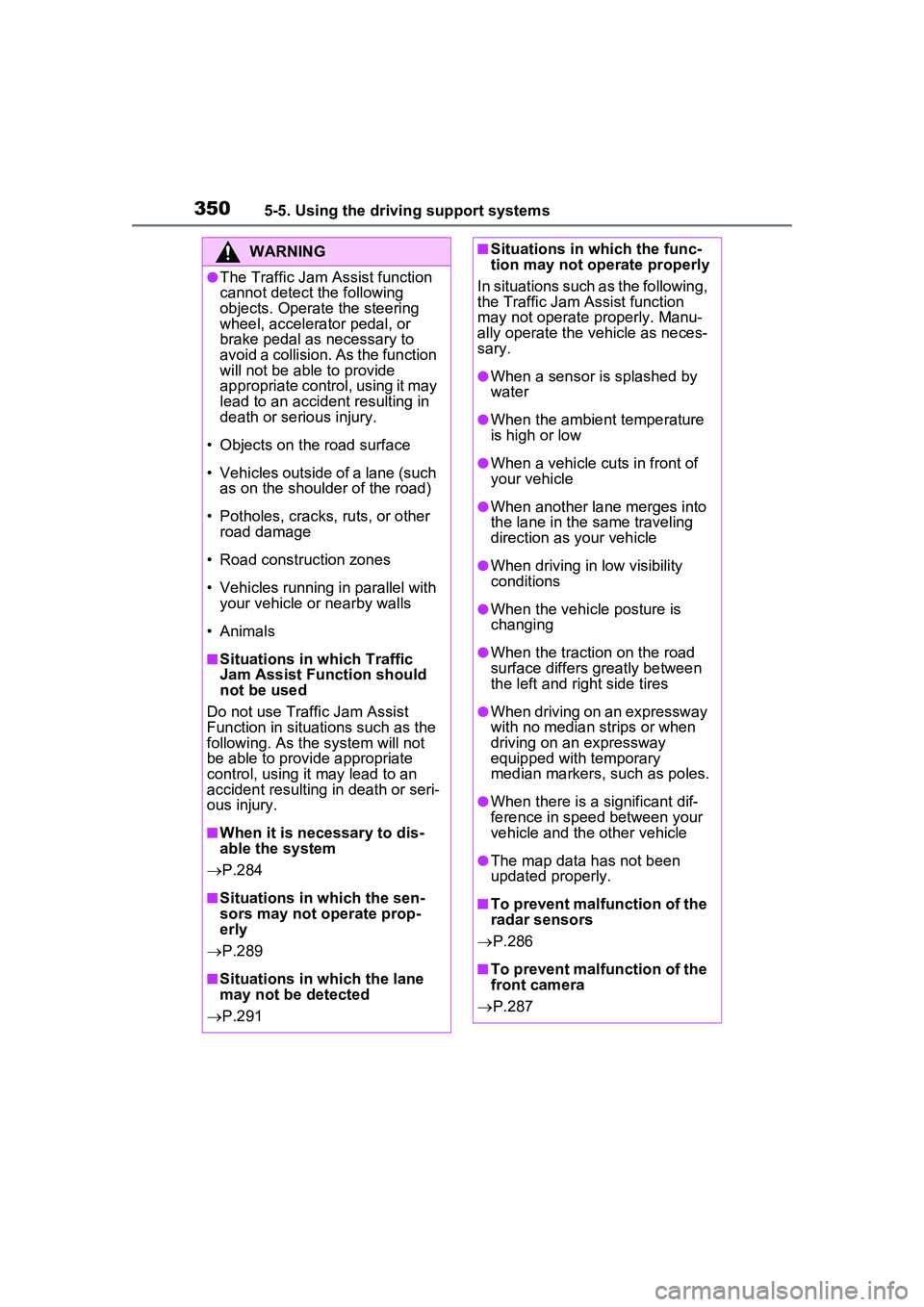
3505-5. Using the driving support systems
WARNING
●The Traffic Jam Assist function
cannot detect the following
objects. Operate the steering
wheel, accelerator pedal, or
brake pedal as necessary to
avoid a collision. As the function
will not be able to provide
appropriate control, using it may
lead to an accident resulting in
death or serious injury.
• Objects on the road surface
• Vehicles outside of a lane (such as on the shoulder of the road)
• Potholes, cracks, ruts, or other road damage
• Road construction zones
• Vehicles running in parallel with your vehicle or nearby walls
• Animals
■Situations in which Traffic
Jam Assist Function should
not be used
Do not use Traffic Jam Assist
Function in situations such as the
following. As the system will not
be able to provide appropriate
control, using it may lead to an
accident resulting in death or seri-
ous injury.
■When it is necessary to dis-
able the system
P.284
■Situations in which the sen-
sors may not operate prop-
erly
P.289
■Situations in which the lane
may not be detected
P.291
■Situations in which the func-
tion may not operate properly
In situations such as the following,
the Traffic Jam Assist function
may not operate properly. Manu-
ally operate the vehicle as neces-
sary.
●When a sensor is splashed by
water
●When the ambient temperature
is high or low
●When a vehicle cuts in front of
your vehicle
●When another lane merges into
the lane in the same traveling
direction as your vehicle
●When driving in low visibility
conditions
●When the vehicle posture is
changing
●When the traction on the road
surface differs greatly between
the left and right side tires
●When driving on an expressway
with no median strips or when
driving on an expressway
equipped with temporary
median markers, such as poles.
●When there is a significant dif-
ference in speed between your
vehicle and the other vehicle
●The map data has not been
updated properly.
■To prevent malfunction of the
radar sensors
P.286
■To prevent malfunction of the
front camera
P.287